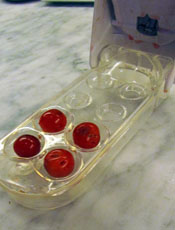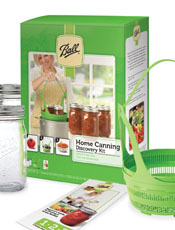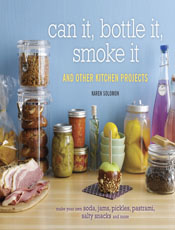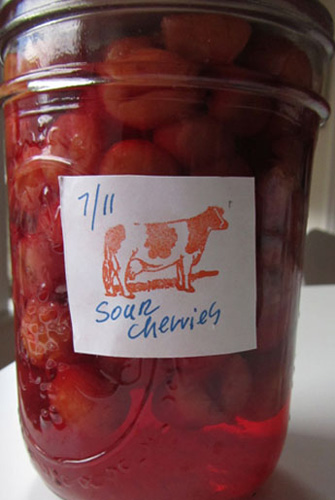Summer Cooking Projects
This past Saturday, when the temperature in my New York City neighborhood topped 100 degrees, I decided to can sour cherries. I figured a little more heat and steam wouldn't matter. Plus it was the end of the cherry season and if I didn't do it now, I'd be out of luck until next year.
Maybe you've noticed that it's been a bad season for sour cherries. As one farmer told me, last spring was wet and cold, causing the cherry blossom buds to freeze and snap right off their trees. So the harvest has been small, late and expensive. But I found some at the Union Square Greenmarket and four quarts of cherries and three hours later, I had six ruby red pints cooling off on my cotton towel-lined counter.
Help For The Tedium: The Cherry-It Pitter
I filled my 21-quart dark blue enamel pot with water, set it on the stove to come to a boil, and turned to the tedious task of cleaning, stemming and pitting the cherries.
I was not enthusiastic, especially since my usual method for cherry pitting is to use the end of a drinking straw -- a low tech method I still recommended, especially if you're pitting smaller amounts. But four quarts? Even after stemming and cleaning, the cherries filled two large colanders. However, this year I had a faster solution thanks to a suggestion from a friend who is less gadget-phobic than I usual am.
The Cherry-It Pitter is an inexpensive and genius device that pits four cherries at a time. It helps keep the mess under control, too, because you place the cherries onto a little tray and then press down the top, as if it were a stapler. The pits either fall through to the tray below or are easily grabbed as they dangle under the cherries. I'd estimate that it reduced by 70% the time I'd otherwise need to pit four quarts of cherries.
Even if you're not planning on canning cherries but like to occasionally make desserts like clafoutis or sweet cherry compote, this is a kitchen tool worth considering. I bought mine on Amazon.com.
Home Canning in City Kitchens
Now in my third summer of "putting up," as the charming expression goes, it's becoming a regular kitchen practice. Come summer and early fall, I will try to catch favorite foods at their peaks and capture them for winter cooking. With limited pantry space to store the jars, I have to keep a relatively narrow focus: besides my six pints of sour cherries, this summer I plan to put up at least six quarts of crushed New Jersey tomatoes (for winter soups and stews) and for the first time, I'm going to try red pepper jelly.
Despite such growing confidence, I'm still a nervous canner, cautious at every step, deliberating over the process, making sure I've not skipped a single thing. Done properly, canning is a wonderful addition to any city kitchen because it lets us preserve the flavors of summer and local produce to enjoy in the winter (those cherries will end up in a dessert or with roasted pork or duck). Done improperly, canned foods can make us sick.
But canning isn't cooking. It's a preservation technique based on food science that home cooks have been practicing for a long time. And frankly, while we increasingly hear about people getting ill from mass-produced foods, I can't remember any time when I've read about someone getting sick from home-jarred apricots or anything else.
I encourage anyone who envies my six pints of sour cherries, or the quart jars of crushed New Jersey tomatoes I expect to have stashed by early September, to give it a try.
Start by doing some reading. I highly recommend the Ball Blue Book of Preserving, published by Ball Corporation, the same folks who for generations have manufactured the glass jars, lids and bands you'll need. Another book I like and use is Well-Preserved by Eugenia Bone who is a very experienced canner -- and a city cook with a small kitchen. See our link to our podcast interview with her about city kitchen canning.
Next, you'll need some tools. A big stock pot, glass jars, lids and bands, and utensils that make it easier and safer to work with a huge pot of boiling water, such as a jar lifter (which are big tongs), and a wand with a magnetic tip to lift metal lids out of hot water. Your canning book will give you more specifics.
Give yourself the time and focus to do the canning properly. You need to take each step completely, without improvising or cutting corners. This means keeping an eye on your filled jars once they're in the boiling water to make sure that the water level remains at least 1 to 2 inches above the jars, and that the water stays boiling for the entire processing time, which can take 45 minutes.
Still feeling intimidated? Here's an easy way to start. Ball Corporation has a new product called the Home Canning Discovery Kit. And it's perfect for the new canner with a small kitchen. The kit contains everything you need to get started. There is a green silicone canning basket with a handle -- this is what is inserted into a stockpot (you probably already have one to make soups) to hold and retrieve 3 pint-sized glass jars that also come with the kit.
Also included is a basic instruction book for safely using your Discovery Kit and recipes to help you get acquainted with the entire canning experience -- pickles, chutneys, salsa, and barbecue sauce. And should you become a city canner and want to do more (and I suspect that after your first canning experience, you will), the kit also has coupons for buying canning jars and the Ball Blue Book.
I first saw this kit demonstrated at a CSA Conference held this past spring where I watched canning virgins make pickled carrots in less than an hour. It's an excellent but low-investment (of money and storage space) way to give canning a try.
You can purchase the Ball Home Canning Discover Kit at Amazon.com or directly from Ball at their online store, FreshPreservingStore.com.
Kitchen Projects -- Beyond Canning
I think the combination of food being over-industrialized, plus toxic scares, rising prices, and the way technology can make us feel further apart despite being more acutely connected has made many of us want to DIY in our kitchens. Canning is just one example.
It's also ironic and confounding that that at a time when more food is locally grown and sold, that the artisanal can be hijacked or priced out of business. For example, whether you loved H&H bagels or found them too doughy isn't really the point when lamenting that an iconic NYC bagel shop has gone out of business -- and not for lack of customers.
Likewise, reading a label (Nutella? corned beef? catsup?) or a price tag (cacao nibs? fruit syrups? candied citrus peel?) can inspire us to make our own. But sometimes all it takes is a craving for domesticity -- or a bagel shop going out of business -- to want to do it ourselves.
If any of this feels familiar, then I am happy to introduce you to a terrific and really fun book called Can It, Bottle It, Smoke It And Other Kitchen Projects ($24.99 hardcover, 160 pages, color photography, Ten Speed Press) by Karen Solomon. At a time when there is no shortage of recipes, this book instead tells us how to make many of the foods we already love or cook with, but instead buy already made.
I first came across Ms. Solomon when I was teaching myself canning and used her previous book, Jam It, Pickle It, Cure It. Both books have an enabling tone, voice, and level of instruction. In her newest, she shows how to make many of our favorite foods and ingredients -- vanilla extract, Ploughman's Pickle, preserved lemons, bagels, English muffins, soy milk, fried pork rinds, ginger beer, and even hot dogs and ice cream cones (plus the ice cream to go in them).
Then there is her recipe for Chocolate Hazelnut Spread. If your children (or you) are fans of the popular Nutella, see our link to Ms. Solomon's version -- minus the commercial version's palm oil and emulsifiers.
Particularly if you like to cook with others, whether it's with kids or friends, this is a book that not only offers fun projects but also reveals what actually goes into making some of our favorite foods.
Last Saturday, after finishing my sour cherries, I used Ms. Solomon's recipe to make Worcestershire sauce. For several months I've been collecting recipes to make my own (I have ambition to make the world's best bloody Mary at summer's end when tomatoes are at their peak and I can make New Jersey tomato juice -- and I wanted to honor the cocktail with something more special than Lea & Perrins). When I received Ms. Solomon's book from her publisher it was her Worcestershire sauce recipe that won me over. It does have 14 ingredients -- from the quotidian like garlic, nutmeg and shallots, to ones you may need to purchase just for the recipe, such as tamarind paste and fish sauce.
Everything gets shaken in a jar that's left in a closet to ferment for two weeks. Fingers crossed because I've got that bloody Mary at stake.



